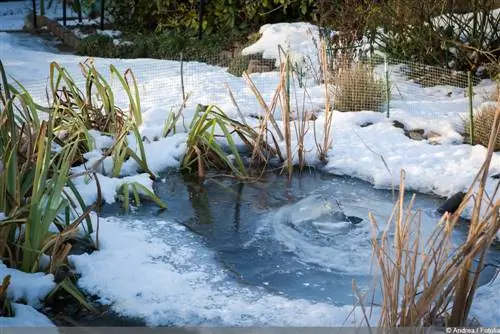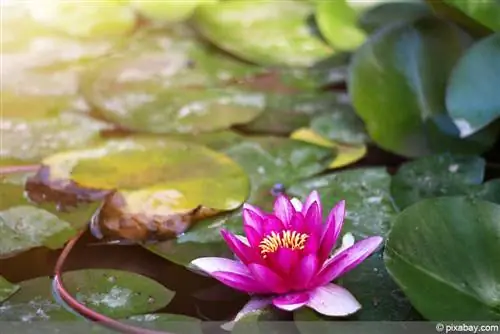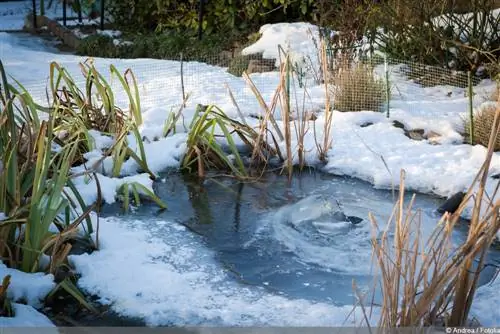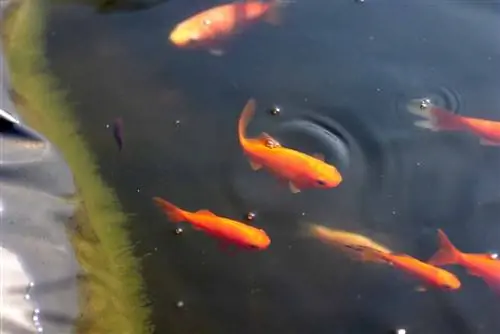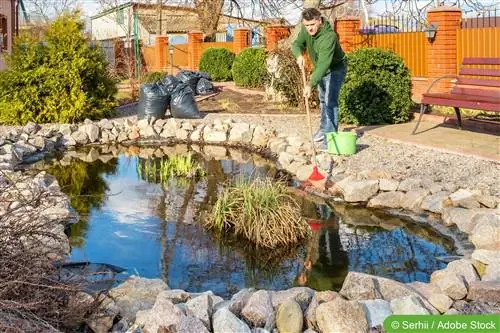- Author admin [email protected].
- Public 2023-12-17 03:39.
- Last modified 2025-01-24 12:45.
Pond plants are not only decorative, but can keep the water clean and protect against algae formation. An important factor is their winter hardiness. Whether they are hardy or not depends on whether they are exotic or native species and where in the pond they are planted. But what about overwintering pond plants?
Not every pond plant is hardy
Native aquatic plants have adapted to the changing seasons in the pond in very different ways. The situation is completely different with tropical species such as water hyacinth, water lettuce or tufted fern. Although they are pretty to look at, they would not survive a winter in or around the pond. They must overwinter frost-free. Hardy aquatic plants can easily overwinter in the pond as long as it is deep enough. For example, the Marino moss ball or the pond liver moss sink to the ground in the deep water area when it is cold. When it gets warmer again, they rise to the surface of the pond. Others remain on the ground in summer and winter, where they grow on stones or wood like spring moss and water grass. Even freezing in ice doesn't bother them.
Then there are aquatic plants that form tubers or rhizomes and behave like normal bulb flowers during the winter. Only the tuber survives and sprouts again in spring. The lively milfoil, some pondweed and frogbit also completely disappear in late autumn and survive in the form of winter buds or permanent stages on the bottom of the pond. Overwintering cold-sensitive pond plants is a bit complicated, but even with hardy specimens you should keep a few things in mind.
Wintering in the pond
In order for pond plants to survive the winter well, proper handling is important. It is best to pay attention to good winter hardiness when purchasing. This has the advantage that the plants can stay in the pond all year round and do not have to be moved before winter like cold-sensitive species. However, protective measures cannot be completely dispensed with.
Shrink overgrown plants
Reeds and other marsh plants in the shallow water zone should be shortened by about half (above the water surface). This prevents brown leaves from falling into the water and sinking to the bottom. It is important that the stalks then protrude about 15 cm above the water, as this is the only way oxygen can be exchanged in the pond and putrid gases can escape from the bottom. For this reason, bank plants should not be completely removed.
Keep evergreen species as ice-free as possible
Evergreen aquatic plants can supply the pond with oxygen in a completely natural way. This requires that they are placed correctly, in ice-free areas of the pond. Wintergreen underwater plants such as spring moss, waterweed or waterstar need sufficient light to be able to photosynthesize and produce oxygen.
Transfer shallow water plants to deeper areas
The swamp water zone is the coldest area of the garden pond during the winter, which can be problematic for pond plants. But the deeper you go, the warmer it gets.
- Grasses in swamp areas tolerate temperatures down to minus ten degrees
- As it gets colder, frost damage cannot be ruled out
- As a precaution, move plants from shallow water areas
- Velvet plant basket in a lower place in the pond
- Relocation is intended to prevent the root area from freezing completely
- Applies even more to partially hardy species
- Return to original location in spring
Other protective measures
- Remove all dead and rotten leaves before winter rest
- Leave leaves of marsh iris, rush and cattail
- They prevent the pond from completely freezing over
- Enable the supply of oxygen
- Cut off yellowed and dead floating leaves from floating plants
- Also remove brown discolored shoots
- Is intended to prevent sinking to the bottom of the pond and the formation of sludge
- Only cut off brown plant parts
The plants store the chlorophyll contained in the green parts of the plant in the rhizomes, which helps them survive the winter better. The planters also need protection. If these are made of earthenware or ceramic, it is advisable to move the plants into plastic containers. Ceramics and earthenware are generally not frost-proof.
Tip:
Appropriate gripping tools and a landing net are ideal for fishing out dead plant parts.
Winter cold-sensitive aquatic plants frost-free
It is a little more complicated to get cold-sensitive pond plants over the winter. This particularly affects species from the tropics such as lotus flowers, mussel flowers, water poppies, water hyacinths and papyrus plants (Cyprus grasses). However, aquatic plants in small ponds that are too shallow and therefore not frost-proof are also affected. Here, even the classic swamp irises and water lilies are not sufficiently hardy. All of these plants have to move to warm winter quarters in the fall. Moving to deeper pond zones is not sufficient here.
Get out of the pond in time
Cold can be fatal for aquatic plants from tropical climates. This makes it all the more important to get them into the house on time. In time means as soon as the night temperatures drop to ten degrees, but in any case before the first frost. If temperatures drop below ten degrees, sensitive plants can suffer significant damage. Depending on the type of plant, you can fish them out with a sieve or lift them out of the pond together with the plant pot and substrate. If you put the plants in small plant baskets in the pond right from the start, removing them in the fall is much easier.
Winter properly
Once the plants have been taken out of the pond, the planters are freed from algae residue and other contaminants. Now is also the best time to remove dead leaves and root parts from the plants, which can prevent the spread of diseases.
- Replace the entire plant substrate before moving
- To do this, remove the old substrate
- Line the plant basket with fleece to prevent the soil from trickling through
- Fill in special pond soil or granules and insert plants
- Commercial potting soil is completely unsuitable
- Nutrients in potting soil promote algae growth
- Now place the newly stocked baskets in a bucket of fresh water
- Then place in a suitable place
- Top up or change water occasionally throughout the winter
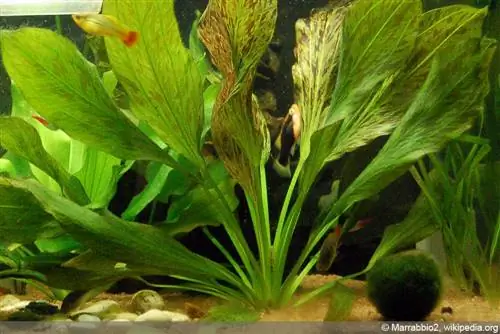
The popular Cyprus grass can also overwinter on a few pebbles in a conventional planter, provided there is always enough water in the pot. Larger species such as the lotus flower can overwinter in a bucket or tub filled with appropriate substrate and water. Floating plants such as fairy moss, water lettuce, water fern or water hyacinth must be completely submerged in water in order to survive. Depending on their size, they can therefore be overwintered in bowls filled with water. Smaller specimens can also spend the winter very well in an aquarium if one is available. In any case, it is important to ensure that the plants always have enough water available and do not dry out.
Conditions in winter quarters
During the rest phase, it is important that the plants' natural requirements for light and temperature are met. They require both heat and sunlight. However, it shouldn't be too warm. Winter gardens, heated greenhouses or an aquarium in the apartment are ideal. An exception are plants that move in in winter; they can also overwinter in a dark cellar.
For most plants, the temperatures in the winter quarters should neither fall below nor exceed ten degrees. If they are well above ten degrees, there is a risk of premature sprouting. When it gets warmer outside again, the pond plants can go back into the garden pond. Depending on the weather, the earliest date for the move is around mid/late May after the Ice Saints. No more night or late frosts should be expected.
Tip:
Plants that particularly require warmth, such as water hyacinths, require temperatures of 15 to 18 degrees to overwinter.
Getting plants in the mini pond over the winter
Mini ponds often only have a water depth of between 30 and 60 cm. This means that they freeze completely in winter. If they are not embedded in the ground, this is much quicker. In addition, the walls can burst due to ice pressure. This can be fatal even for hardy pond plants. With the right winterization you can avoid all of this.
- First drain the water
- Radically shorten the leaves and tendrils of plants
- Place plant baskets including soil and roots individually in plastic pots
- Fill the bucket with water up to the top edge of the baskets
- Check the water level regularly and refill if necessary
- Alternatively, transport the pond completely to its winter quarters
- Depending on local conditions
- First drain the water to a few centimeters and shorten the plants
- Water levels of around five centimeters are usually sufficient
- Winter quarters cool and dark, with temperatures not exceeding ten degrees
Tip:
If the plants in the mini pond also include exotic plants, overwinter them as already described, brightly, at slightly warmer temperatures.

